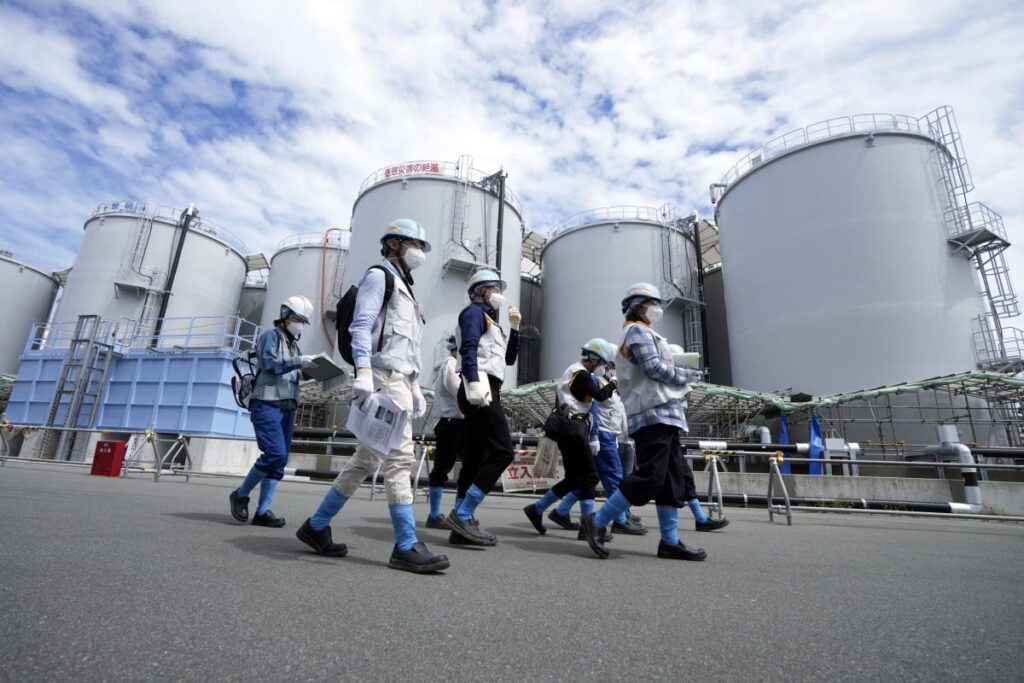Why Do Many Scientists Oppose Fukushima Radioactive Waste Discharge?
ENVIRONMENT, 4 Sep 2023
Victoria Bela | South China Morning Post - TRANSCEND Media Service

Journalists pass tanks containing treated radioactive wastewater at the Fukushima discharge facility in Japan. Photo: EPA
The release of treated waste water from the nuclear plant has begun, despite concerns from major scientific organisations. IAEA is monitoring the operation but many experts are questioning the amount of data being collected.
30 Aug 2023 – Japan’s decision to start releasing around 30 years’ worth of treated radioactive waste into the Pacific Ocean on August 24 has drawn criticism from some countries, including China, as well as some of the world’s leading scientific organisations.
While some scientists support this approach, on the grounds that the tritium to be released is not detrimental to human or environmental health, there is widespread sentiment against it in the mainstream scientific community.
The South China Morning Post examines the nature of the opposition to the release of the radioactive water.
1. Why is the scientific community concerned?
Tritium is one of two chemicals that Japan’s advanced liquid processing system (ALPS) is unable to filter out and has been the focus of the argument that releasing the water is safe.
However, the ALPS has been shown to be unsuccessful in filtering out the other 62 radioactive chemicals present in the waste water, according to data from the Japanese ministry for economy, trade and industry (METI).
According to METI, around 70 per cent of ALPS-treated water still contained radioactive substances other than tritium by the end of 2020, and needed to be repurified.
The US-based National Association of Marine Laboratories (NAML), which represents more than 100 labs, released a position paper in December 2022 that firmly opposed Japan’s plan over “a lack of adequate and accurate scientific data” about its safety.
NAML members include some of the world’s most influential marine research institutes, including the Scripps Institution of Oceanography at the University of California, San Diego.
In particular, NAML was concerned about the “absence of critical data on the radionuclide content of each tank”. The information has yet to be publicly released by METI and plant operator the Tokyo Electric Power Company (Tepco).
Radioactive isotopes like caesium-137, strontium-90 and iodine-131 are just some of the chemicals contaminating water that came into contact with the melted nuclear reactor core.
Exposure to these isotopes can increase risks for various types of cancer – especially when ingested, according to the US Environmental Protection Agency (EPA).
The NAML warns that these radioactive chemicals, which have long half-lives, will continuously accumulate through marine food chains, regardless of how much they are diluted in the ocean.
This raises the concern that eating affected seafood like fish and lobster could cause DNA damage and an elevated cancer risk for humans. The worry was compounded in May, when a fish caught by Tepco near the plant’s drainage outlets registered caesium-137 levels 180 times higher than the maximum legal limit.
The discharge operation is also opposed by the International Physicians for the Prevention of Nuclear War, which issued a statement in May saying “the Pacific Ocean must not be a radioactive waste dump”.
2. Can other countries monitor the radiation levels?
No, although China intends to monitor marine radiation in areas under its jurisdiction to track any possible impacts from the Fukushima waste water discharge.
The International Atomic Energy Agency (IAEA) is maintaining an on-site presence at the plant and started a live tracker on August 24 of data, which includes the concentration of diluted tritium, discharge flow rate and radiation monitoring.
Green points on the tracker mean measurement levels are within expected levels and red points mean there are abnormal levels that require attention. The IAEA website notes that the information and data are provided by Tepco.
The IAEA’s Gustavo Caruso, director and coordinator for the ALPS safety review, said the Tepco data “is just a single piece of the overall monitoring approach”.
The IAEA will also observe measurements and samples, conduct review missions to observe activities, and request additional data as part of its monitoring role.
However, Tepco’s data is confined to tritium levels and gamma radiation at the plant. While this would pick up caesium-137 and iodine-131, which emit gamma rays, strontium-90 does not, according to the EPA.
China has been one of the fiercest critics of the waste water release and marked the start of the operation by announcing that it will monitor marine radiation levels “to track and judge the possible impact of the nuclear-polluted water discharge”.
An unnamed National Nuclear Safety Administration official from China’s ecology and environment ministry said on August 24 that previous monitoring in 2021 and 2022 of marine radiation within its jurisdiction had found no abnormalities.
3. What is Tepco’s track record on data transparency?
In 2013, Tepco attracted criticism when it acknowledged that 20 to 40 terabecquerels of tritium had leaked from the power plant in the two years after the disaster, despite previous denials.
Tepco was also criticised for not providing testing results for other radioactive chemicals known to be present in the waste water, and has continued to withhold this data since then.
In its position paper, the NAML described the data provided by Tepco as “insufficient, and in some cases incorrect” and flagged flaws in its scientific protocols for sampling and statistical analyses, which it said could lead to a false conclusion of safety.
In March, Chinese foreign ministry spokesman Sun Xiabao questioned the trustworthiness of the treatment process and data, noting that media reports suggested Tepco had “a track record of data tampering”.
4. How will the radioactive elements spread over time?
A Tsinghua University research team created a model to simulate how tritium from the Fukushima waste discharge could diffuse across the world.
The results, published by Science China Press on August 25, suggest it would take eight months for the released tritium to reach the waters east of Taiwan, and 3.3 years to arrive in the seas to the west of Canada and the United States.
The model showed the western coast of the US will receive the highest concentration, with San Diego set for a higher average concentration level than Miyazaki in Japan, despite reaching there last.
The researchers said their model factored in migration, dispersion and radioactive decay before calculating the spread in small squares across the sea. Their analysis did not include caesium-137, strontium-90 or iodine-131.
The report also acknowledged that the amount of tritium being released is not large compared to the background concentrations present in the ocean.
5. Should you be concerned about the release?
Tepco and the IAEA insist that the release of waste water is safe and poses no threat to health but organisations like NAML remain concerned about whether the operation is scientifically sound.
According to NAML, Japan has not adequately explored other options to store and dispose of the waste and the effectiveness of the ALPS treatment “remains a serious concern”.
NAML said its members are unified in their concern “about the use of the oceans as a dumping ground for radioactively contaminated water” because of the potential long-term consequences it can have on our health and our planet.
While many governments have accepted the safety arguments for the Fukushima release, China has addressed the issue by banning imports of Japanese seafood, citing the long-term concern over the accumulation of radioactive chemicals.
______________________________________________
 Prior to joining SCMP in 2023, Victoria Bela received her Bachelor’s degrees in Environmental Health and Environmental Studies from the University of Rochester, where she also worked in a Biochemistry lab. She holds a Master’s in Public Policy from Peking University.
Prior to joining SCMP in 2023, Victoria Bela received her Bachelor’s degrees in Environmental Health and Environmental Studies from the University of Rochester, where she also worked in a Biochemistry lab. She holds a Master’s in Public Policy from Peking University.
Tags: Environment, Fukushima, Marine pollution, Nuclear Waste, Oceans, Radioactive Waste
DISCLAIMER: The statements, views and opinions expressed in pieces republished here are solely those of the authors and do not necessarily represent those of TMS. In accordance with title 17 U.S.C. section 107, this material is distributed without profit to those who have expressed a prior interest in receiving the included information for research and educational purposes. TMS has no affiliation whatsoever with the originator of this article nor is TMS endorsed or sponsored by the originator. “GO TO ORIGINAL” links are provided as a convenience to our readers and allow for verification of authenticity. However, as originating pages are often updated by their originating host sites, the versions posted may not match the versions our readers view when clicking the “GO TO ORIGINAL” links. This site contains copyrighted material the use of which has not always been specifically authorized by the copyright owner. We are making such material available in our efforts to advance understanding of environmental, political, human rights, economic, democracy, scientific, and social justice issues, etc. We believe this constitutes a ‘fair use’ of any such copyrighted material as provided for in section 107 of the US Copyright Law. In accordance with Title 17 U.S.C. Section 107, the material on this site is distributed without profit to those who have expressed a prior interest in receiving the included information for research and educational purposes. For more information go to: http://www.law.cornell.edu/uscode/17/107.shtml. If you wish to use copyrighted material from this site for purposes of your own that go beyond ‘fair use’, you must obtain permission from the copyright owner.
